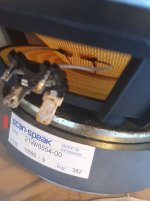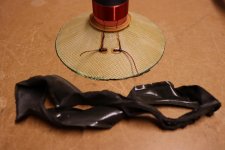I have a pair of speakers that use the discontinued Scan-Speak 21W/8554-00, but unfortunately one has just stopped working (no obvious signs of damage).
I was wondering if anyone knows of a source of this driver (in the UK), or might have suggestions for possible repairs?
I was wondering if anyone knows of a source of this driver (in the UK), or might have suggestions for possible repairs?
You will need to match it to the original spec-
https://www.scan-speak.dk/datasheet/archive/21w-8554-00.pdf
https://www.scan-speak.dk/datasheet/archive/21w-8554-00.pdf
Yep - but unfortunately my investigations so far have ticked off pretty much all the UK distributors (still awaiting a response from one), as well as a few Danish and Dutch sellers. Apparently it's been discontinued for long enough that there just aren't any left, and there isn't a direct replacement from Scan-Speak.
Currently looking at options of repair (though I'm unsure how well that would go), or essentially having to start fresh and build something entirely new.
Currently looking at options of repair (though I'm unsure how well that would go), or essentially having to start fresh and build something entirely new.
If it the actual speaker itself that's dead then it must be a voice coil breakage .
If you can take it apart you might find where its broken , usually overdriven and the heat generated either blows the winding or it short circuits .
Are you measuring any resistance or is it open circuit ?
If you can take it apart you might find where its broken , usually overdriven and the heat generated either blows the winding or it short circuits .
Are you measuring any resistance or is it open circuit ?
I think voice coil is the most likely; from what I've been able to test of the crossover I think it looks OK. The DC resistance across the driver terminals is around 30 M Ohm.
As far as I can see the only way to access the voice coil is to cut through the rubber surround to the driver - so definitely a destructive investigation. I found one report of someone having this driver repaired (professionally) but apparently it changed the driver's behaviour quite a bit.
As far as I can see the only way to access the voice coil is to cut through the rubber surround to the driver - so definitely a destructive investigation. I found one report of someone having this driver repaired (professionally) but apparently it changed the driver's behaviour quite a bit.
At 30Mohm its a break in the voice coil wiring , its a pity magnets are fixed to the chassis of speakers as I used to remove them and resolder the wire on the coil .
Not easy to do and I had to re-centre it accurately to avoid scraping the sides.
Yes the surrounds can be replaced but its got to be the correct type of material .
Not easy to do and I had to re-centre it accurately to avoid scraping the sides.
Yes the surrounds can be replaced but its got to be the correct type of material .
30 M ohm which I interpret as 30,000,000 ohms. I doubt you mean mill ohms as that would be a very good short circuit.
Looking carefully at the speaker chassis signal connectors verify that the tinsel lead is still intact on both + and - sides and is not corroded or broken where it is soldered to the terminals.
If this checks out as good, can you see where the tinsel wire goes through the cone. I guess it is under the dust cap area. Which will need somebody to gently separate the dustcover away from the cone to trace the fault further(Scalpel and a steady hand, once you can ease through the glue they sometimes can be peeled quite easily).
If it is broken at that interface you may be able to bridge it with a thin piece of wire and a very fast application of solder so as not to burn the cone. If you are not comfortable with this it may be time to seek out a speaker restorer to help.
What is the design are the speakers are used in was it a UK sourced Kit?
Looking carefully at the speaker chassis signal connectors verify that the tinsel lead is still intact on both + and - sides and is not corroded or broken where it is soldered to the terminals.
If this checks out as good, can you see where the tinsel wire goes through the cone. I guess it is under the dust cap area. Which will need somebody to gently separate the dustcover away from the cone to trace the fault further(Scalpel and a steady hand, once you can ease through the glue they sometimes can be peeled quite easily).
If it is broken at that interface you may be able to bridge it with a thin piece of wire and a very fast application of solder so as not to burn the cone. If you are not comfortable with this it may be time to seek out a speaker restorer to help.
What is the design are the speakers are used in was it a UK sourced Kit?
Indeed. If the magnet could be removed it might not be that hard to fix, but I guess it reduces the manufacturing cost to make it the way they do.At 30Mohm its a break in the voice coil wiring , its a pity magnets are fixed to the chassis of speakers as I used to remove them and resolder the wire on the coil .
Not easy to do and I had to re-centre it accurately to avoid scraping the sides.
Yes the surrounds can be replaced but its got to be the correct type of material .
30 M ohm which I interpret as 30,000,000 ohms. I doubt you mean mill ohms as that would be a very good short circuit.
Looking carefully at the speaker chassis signal connectors verify that the tinsel lead is still intact on both + and - sides and is not corroded or broken where it is soldered to the terminals.
If this checks out as good, can you see where the tinsel wire goes through the cone. I guess it is under the dust cap area. Which will need somebody to gently separate the dustcover away from the cone to trace the fault further(Scalpel and a steady hand, once you can ease through the glue they sometimes can be peeled quite easily).
If it is broken at that interface you may be able to bridge it with a thin piece of wire and a very fast application of solder so as not to burn the cone. If you are not comfortable with this it may be time to seek out a speaker restorer to help.
What is the design are the speakers are used in was it a UK sourced Kit?
Yea, 30 M Ohm not mill; so "open" rather than shorted.
The leads look OK (see the attached image). The discolouration on the speaker terminals is flux; not rust or burning.
It was from a Wilmslow Audio Nemesis; a pair of ported floorstanding speakers, also using the D2905/9500 tweeter. Sounded really good. To be fair they're >15 years old, and have withstood two house moves.
Attachments
Looking at your image, the voice coil wires appear as if they are joined to the tinsel and then go straight down to the voice coil, not joined under the dust cap. Tricky!! it still might be worth trying some gentle pressure on the tinsel lead to verify it isnt broken and corroded just behind the terminal?
The discovery series 8 inchers are now 225 outside diameter, where your originals flush mounted? Going from 222 to 225 can be a bit of a pain, but achievable with care.
If not a Scan-Speak 22w 85430G000may get you approximately there. Although less sensitive which would possibly require some resistance changes for the tweeter to align to the newer slightly less sensitivity.
The discovery series 8 inchers are now 225 outside diameter, where your originals flush mounted? Going from 222 to 225 can be a bit of a pain, but achievable with care.
If not a Scan-Speak 22w 85430G000may get you approximately there. Although less sensitive which would possibly require some resistance changes for the tweeter to align to the newer slightly less sensitivity.
Looking at your image, the voice coil wires appear as if they are joined to the tinsel and then go straight down to the voice coil, not joined under the dust cap. Tricky!! it still might be worth trying some gentle pressure on the tinsel lead to verify it isnt broken and corroded just behind the terminal?
The discovery series 8 inchers are now 225 outside diameter, where your originals flush mounted? Going from 222 to 225 can be a bit of a pain, but achievable with care.
If not a Scan-Speak 22w 85430G000may get you approximately there. Although less sensitive which would possibly require some resistance changes for the tweeter to align to the newer slightly less sensitivity.
It's worth a try to see if the wiring has become flaky (I'll give it a go when I get chance).
I had flush mounted the drivers. The big problem would be crossover changes required to make the best use of a different driver. At that point it may just make more sense to build something new.
I think what's happening to these drivers is the Kevlar hanging onto humidity and contaminating the tinsel/VC connection over time. Corrosion gets started and eventually you have no more connection, even though the voice-coil is still fine. (Check out the photo.)
Also, the surrounds on these have a limited lifetime.
This particular driver had a third issue so I decided to tear it apart. In addition to the corrosion, the surround is a sticky/gooey mess. 🙂
Dave.
Also, the surrounds on these have a limited lifetime.
This particular driver had a third issue so I decided to tear it apart. In addition to the corrosion, the surround is a sticky/gooey mess. 🙂
Dave.
Attachments
With this particular driver it was definitely user error. Fortunately I have managed to source a few spares from private buyers; all in good condition, with the surrounds looking healthy.
- Home
- Design & Build
- Parts
- Scan-Speak 21W/8554-00 replacement (or repair)?

